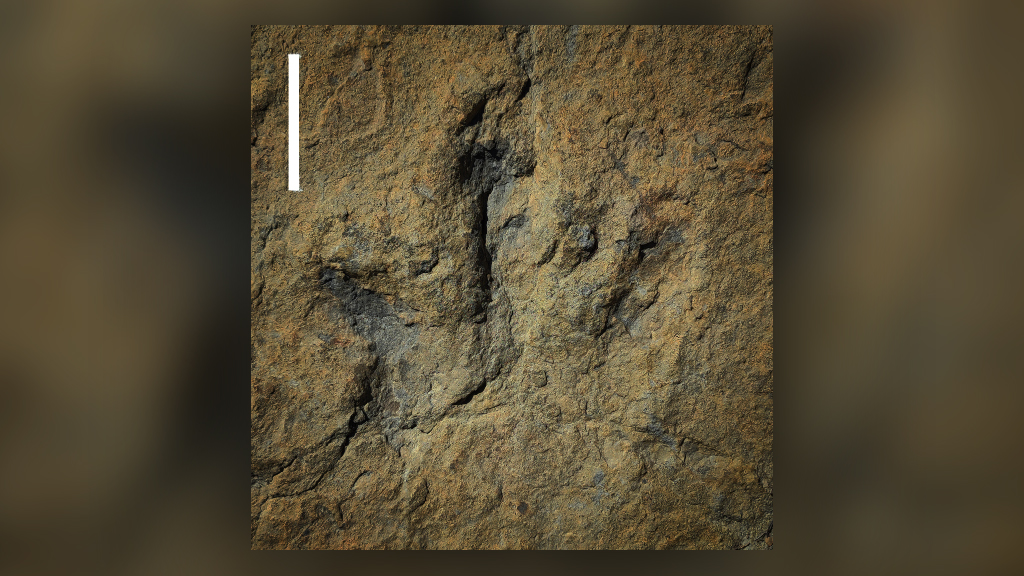Meat-eating dinosaurs were terrifyingly fast, footprints reveal
Theropod tracks provide a snapshot of dinosaurs' running speeds.

Three-toed, meat-eating dinosaurs may have sprinted as fast as a car driving on city streets, new research shows. That finding comes from analyzing the footprints these theropods left behind as they dashed over squishy lake bed mud tens of millions of years ago.
Two sets of fossilized footprints at a site in La Rioja, Spain show that the makers of the tracks were galloping along at speeds up to 27.7 mph (44.6 km/h), reaching "some of the top speeds ever calculated for theropod tracks," according to the new study.
According to researchers' analysis of the tracks, one dinosaur sped up steadily and consistently as it ran, while the other quickly changed its speed while still on the move. Together, these two sets of footprints from the early part of the Cretaceous period (145 million to 66 million years ago) offer a unique snapshot of dinosaur mobility and behavior.
Related: In images: Tyrannosaur trackways
Paleontologists use several methods to calculate running speeds in extinct dinosaurs, said Pablo Navarro‐Lorbés, a researcher at the University of La Rioja in Logroño, Spain and lead author of the new study. One method builds biomechanical models based on dinosaur bones and limb proportions, "and the other main one is the speed estimation from tracks," Navarro‐Lorbés told Live Science in an email.
One set of the La Rioja tracks, dubbed La Torre 6A-14, preserves five three-toed footprints that were each about 12.9 inches (32.8 centimeters) long and 11.9 inches (30.2 cm) wide. The other trackway, La Torre 6B-1, includes seven three-toed footprints that were a little smaller, measuring 11.4 inches (28.9 cm) long and 10.6 inches (26.9 cm) wide. Based on the size of the prints, hip height of the theropods would have been between 4 to 5 feet (1.1 to 1.4 meters), so the animals would have stood about 7 feet (2 m) tall and measured around 13 to 16 feet long (4 to 5 m) "from the snout to the tip of the tail," Navarro‐Lorbés said.
While it isn't possible to tell what genus of theropod made the tracks, similarities between the footprints hinted that the two dinosaurs belonged to the same taxonomic group, were non-avian — not one of the lineages directly related to modern birds — and were "very agile," according to the study.
Sign up for the Live Science daily newsletter now
Get the world’s most fascinating discoveries delivered straight to your inbox.

To calculate the theropods' running speeds, the researchers used a formula that incorporated the dinosaurs' hip heights and stride length. This enabled them to not only calculate the animals' speed with every step but also detect speed variations "like acceleration or deceleration," Navarro‐Lorbés explained. They found that the dinosaur that made the 6A-14 trackway reached just over 23 mph (37 km/h), while the speedier 6B-1 dinosaur scampered into the lead with a top speed of nearly 28 mph (45 km/h).
By comparison, the fastest speed ever clocked in a human runner is 27.5 mph (44.3 km/h), which was achieved very briefly by the famed Jamaican sprinter Usain Bolt in 2009, according to The New York Times.
But while Bolt's running prowess has been well-documented, extinct dinosaurs aren't so lucky. Trackways that can reveal their running speeds are exceptionally rare, so these footprints from northern Spain provided a unique opportunity for the researchers to corroborate theropod speed estimates that were previously produced by other scientists who were analyzing the animals' bones, Navarro‐Lorbés said.
"Fast-running theropod tracks are scarce in the fossil record," Navarro‐Lorbés said. "Being able to study them and confirm some other studies made from different approaches are great news for us."
The findings were published online Thursday (Dec. 9) in the journal Scientific Reports.
Originally published on Live Science.

Mindy Weisberger is an editor at Scholastic and a former Live Science channel editor and senior writer. She has reported on general science, covering climate change, paleontology, biology and space. Mindy studied film at Columbia University; prior to Live Science she produced, wrote and directed media for the American Museum of Natural History in New York City. Her videos about dinosaurs, astrophysics, biodiversity and evolution appear in museums and science centers worldwide, earning awards such as the CINE Golden Eagle and the Communicator Award of Excellence. Her writing has also appeared in Scientific American, The Washington Post and How It Works Magazine. Her book "Rise of the Zombie Bugs: The Surprising Science of Parasitic Mind Control" will be published in spring 2025 by Johns Hopkins University Press.









